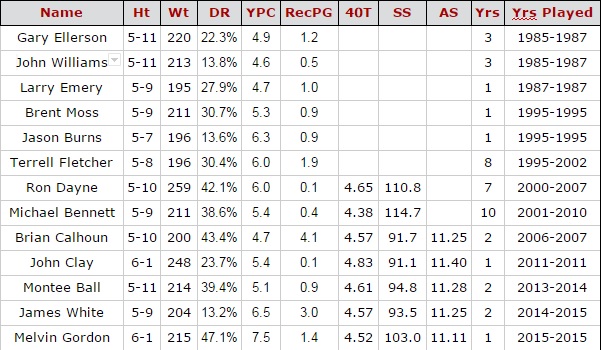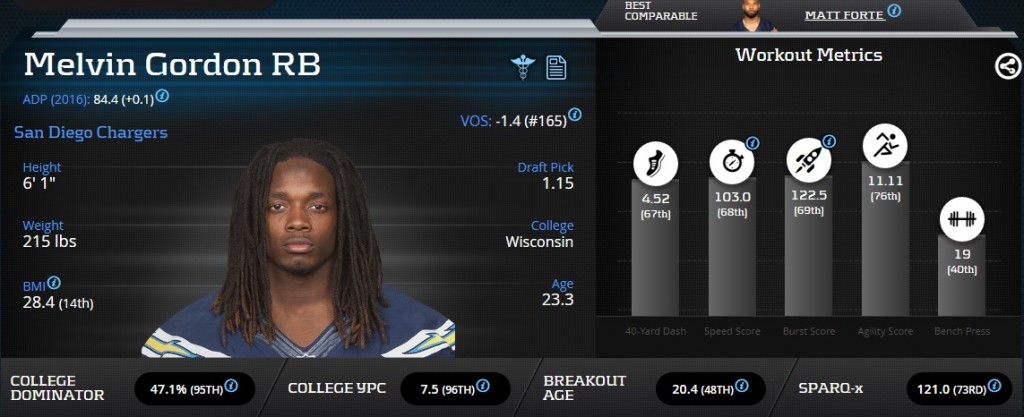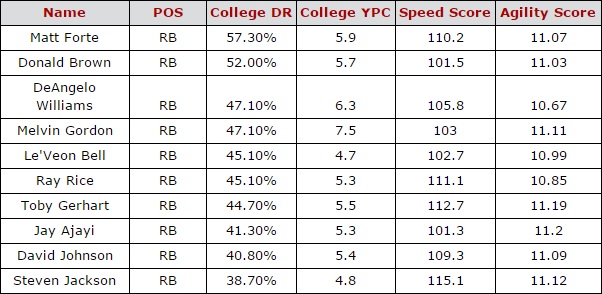The Myth Of The Wisconsin Running Back goes something like this: Wisconsin’s offensive line is so perennially dominant that it made even the below replacement Montee Ball look like Ezekiel Elliott during Ball’s time running through the widest possible lanes during his reign over Big 10 conference defenses. If Montee Ball was revealed to actually be bad, then Melvin Gordon must also be bad. There’s never been a good Wisconsin running back.
Every time I hear some version of this I cringe at the logical fallacy. Just because there has been no star Wisconsin running back does not mean it’s impossible for there to be one. Usually this narrative is followed by “well, there hasn’t been, so there must be something to it.” Time to blow that out of the water by proving Melvin Gordon is the best Wisconsin RB prospect of all time.
A Historical Context
As a PlayerProfiler.com reader, you are already aware of the flaws of basic counting stats. Advanced metrics that take into account relative production are necessary to determine a player’s true productivity. I gathered a list of Wisconsin running backs who entered the NFL since 1985, then whittled out the college returners/special teams players who were only listed as running backs in college. Using this list I built out historical College Dominator Ratings for all of them to list alongside other relevant metrics like Yards Per Carry, receiving usage, and physical metrics such as 40-Time, Speed Score, and Agility Score.
Unfortunately, reliable combine/pro day data doesn’t start until 1999, so I do not have data on several Wisconsin running backs. However, since none of them come anywhere close to matching Melvin Gordon on overall production so this should not be a problem.
Terrell Fletcher and Ron Dayne both had long NFL careers, although neither ever hit RB2 level in fantasy. Michael Bennett actually put up a pro bowl season and a high end RB2 finish before a foot injury derailed him in his 3rd year. Similarly Brian Calhoun had an ACL tear in his rookie year; Back in 2006 these were still a major deal that players often did not recover from. It’s no coincidence that, along with Montee Ball, these were the only marginally comparable players on the list. However, none of these players were Melvin Gordon-level prolific. Melvin Gordon’s 2,587 rushing yards in 2014 were the second highest single-season rushing total in college football history. What? Let me restate that last statistic for effect. Melvin Gordon’s 2,587 rushing yards in 2014 were the second highest single-season rushing total in college football history. Beyond raw totals, Gordon’s 47.1-percent (95th-percentile) College Dominator Rating and 7.5 collegiate yards per carry (96th-percentile) make him the most prolific college running back in the NFL today. And among historical Wisconsin running backs, Gordon’s college YPC leads all former Badger RBs by at least a full yard.
Of the current NFL backs from Wisconsin, Montee Ball and James White, both fall dramatically short of Melvin Gordon for different reasons. Ball had solid production in college with his 39.4-percent College Dominator Rating, but his 7th-percentile SPARQ-x Score revealed that Ball lacked requisite NFL athleticism and stands in stark contrast to Gordon’s 73rd-percentile SPARQ-x. White on the other hand, posts a respectable physical profile with a 60th-percentile SPARQ-x, but only accounted for a meager 13.2-percent College Dominator Rating.
Furthermore, what are the odds that the University of Wisconsin, not exactly an Alabama-esque college football recruiting powerhouse, fields the best five offensive lineman every year? What are the odds that, of the hundreds of programs across college football, the University of Wisconsin perennially features the most efficient run blocking offensive line in college football every season? Answer: Zero. Logically, no ever-changing college offensive line is capable turning water into wine, bad running backs into historic ones, for 30-straight seasons.
A Bell Cow Profile
So Melvin Gordon is clearly the best Wisconsin running back prospect. However, just like being from Wisconsin doesn’t automatically make him bad, being the best from his school doesn’t mean he’s necessarily good. Who are his similar NFL Prospects? Using the PlayerProfiler Data Analysis Tool and filtering the result I came to the below list of similar players. These are all current players with a College Dominator Rating similar to Gordon, a Speed Score over 100, and an Agility Score under 11.20.
Matt Forte, DeAngelo Williams, Le’Veon Bell, Ray Rice, David Johnson, Steven Jackson. Thats one heck of a comp list. You’ll notice again Gordon’s collegiate yards per carry is well above any of the listed players. I don’t think it’s a stretch to say Melvin Gordon profiles like an elite running back in the NFL.
Glimmer of Hope
Melvin Gordon’s rookie season was fairly awful. His -24.1 (No. 72) Production Premium and 3.5 (No. 71) professional yards per carry represented league-bottom efficiency. However, Gordon is no Andre Williams. His anemic rookie season offers rays of hope.
Last season, Melvin Gordon forced 57 missed tackles (No. 16) while maintaining his 47.5-percent Opportunity Share while running behind a Chargers offensive line that ranked No. 31 in run blocking efficiency via FootballOutsiders.com. Gordon’s first year in the NFL crucible will be remembered as one of the challenging experiences for a rookie running back. Yet, despite suffering a serious knee injury in the process, Melvin Gordon persevered. He demonstrated the tenacity and resilience to be a bell cow back in the NFL for years to come.
Conclusion
Like Ryan Mathews five years prior, Melvin Gordon‘s production and efficiency also fell short of the heightened expectations of a first round pick. But like Mathews bounced back and exceeded 1,500 total yards as a sophomore, Gordon is poised to leverage his first-round talent profile and become something significantly closer to the workhorse in 2016 that the Chargers drafted in 2015.
While Melvin Gordon will not be an every-down back due to the presence of Danny Woodhead, he should receive more high leverage opportunities in 2016. Woodhead is now 31-years old and each of those 200 rookie year touches were like trust deposits. Charges coaches will likely trust Gordon more in the red zone after he averaged less than 1.0 red zone carries a game last season.
Giving up on Melvin Gordon after an underwhelming rookie season would be a major mistake. From Le’Veon Bell to Ryan Mathews to Matt Forte, inefficient rookie seasons are the norm. Gordon’s fellow first-rounder Todd Gurley is the outlier. No sophomore running back with Gordon’s college production, athletic profile, and draft position has ever been this inexpensive to acquire, particularly in dynasty leagues. Take advantage of the recency bias-soaked reactionary negativity and grab as much Melvin Gordon as you can possibly get your hands on.





